
G-AMSV Returns to Coventry
An old friend returned to Coventry yesterday when G-AMSV, in her striking Indian Air force livery, landed here for extensive maintenance by our engineers. Sierra Victor was part of the Air Altantique fleet here for many years. She'll...
Baginton Air Pageant
The initial details for the Baginton Air Pageant are up on the website! As we don't have the space for a full-on air show attracting 20,000 or so people, we're aiming for low-key, themed days like this. A couple of thousand people,...
Newquay Pleasure flights
We promised we'd be back to fly in Cornwall, and here we are. We'll be heading south with a Rapide and Chipmunk to spend a week at Newquay from 25th July, with a further visit planned in August. The flights are bookable in the normal...
New Dakota Book
Geoff Jones just told me that his new book on the DC-3, released to celebrate the 80th anniversary of the Dak's appearance, is now available. The cover sports a lovely shot of G-ANAF, shot by Simon Westwood before her radome goiter was...
Nimrod Engine Run
We've just confirmed plans by NPT to run all four of the Nimrod's Rolls-Royce Speys on Saturday 9th May. We expect the thunder to start just after lunchtime. Come along and enjoy some audio power - and please dip into your pockets...

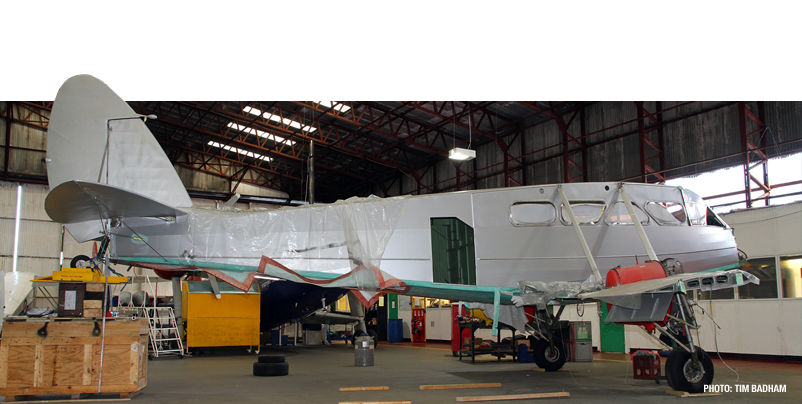
Labours of Love
There are few things as fragile as an old aircraft. So bringing them back from the brink of extinction is a gigantic task. We have a talented and dedicated team of volunteers and technicians who work tirelessly to locate incredibly rare parts, to track down elusive plans and paperwork, and to put in hours of hard work with emery paper and files. Here's an update on the status of a few of our current patients.
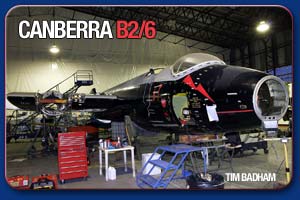
Our record breaking Canberra is undergoing a scheduled major inspection, part of which is a full corrosion report. While we remain hopeful of flying her again this year, the expense of the work will inevitably constrain us. We'll shortly be announcing an exciting initiative to raise funds.
Engines
Some corrosion has been discovered while deep-stripping and inspecting the engines. It’s too early yet to predict what this means as far as their continued serviceability, but a recent Aviation Safety Review suggests that it may be possible to remedy the corrosion rather than replace the engines.
Airframe
The airframe overhaul is progressing very well, with the extensive work carried out on the cockpit really starting to show results. Several components have been removed and sent away for servicing. They should be back with us shortly and, after inspection, we can commence the rebuild.
Once the Canberra has been rebuilt we’ll turn to a full repaint. Funds permitting, we’re hoping to get her to a respray hangar equipped with a low-bake oven. Not only will this make her look superb, it will considerably improve her corrosion resistance.
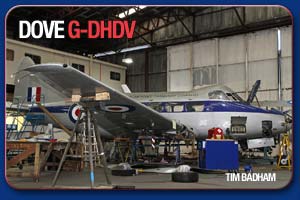
G-DHDV, one of our two de Havilland Doves (or Devons, depending which way you look at them) has been grounded for some time now. Both her lower wing fittings need replacement. As we’ve been able to source only one replacement fitting we’re planning on fitting the wings from our other Dove, G-ARHW.
Hotel Whisky’s starboard wing fitting is in excellent condition, but the port fitting needs to be replaced with the one new component we have. A new tool has been manufactured and trialled for reaming the centre section spars and the centre section has been refurbished ready for the wing graft. Meanwhile, the engine bearers have been x-rayed and and both sides passed without problems. The engines are now being reassembled.
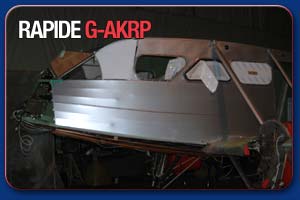
Romeo Papa was in a sad state when she joined us around five years ago. She’d been stored outside and had suffered seriously from the elements. Under the skin inspection revealed severe deterioration of the airframe and the decision was eventually taken to remove all of the fabric and begin a major renovation.
She's an unusual specimen, fitted with variable pitch propellers, and she'll be a superb addition to the fleet when she's fully recovered.
Engines
Both engines are unserviceable. A minor modification will be applied shortly, but it’s likely that the engines will need to be sent out for major work.
Airframe
The fuselage framework has been fully restored and new fabric applied and sprayed silver. The wings are almost complete now, with ailerons currently being covered. Then it’s a case of working on the attachment hardware to allow the wings to be fitted to the fuselage, at which point it’ll look like an aeroplane again! That puts us about half way there...
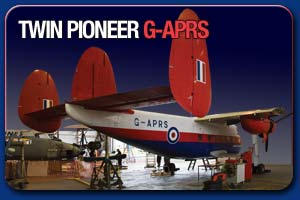
"Primrose", our unique Scottish Aviation Twin Pioneer, has been one of the most sorely missed aircraft on our long-term sick list. The problem arose some five years ago when the wing braces were judged to be out of serviceable life. We began a worldwide search to find replacements and finally found what we needed in Australia. Getting them back to the UK was a long and expensive enterprise, but finally, with considerable excitement, we uncrated them and fitted them to the aircraft.
They didn't fit.
You can easily imagine our disappointment and frustration. What made it worse was that the incompatibility was so slight. The braces went on without difficulty, but they protruded slightly too far to allow the outer skin to be fitted. It's not an uncommon problem with vintage aircraft. Modifications were recorded by writing in a book with a fountain pen. There could be a dozen such books in existence, none of which would contain all the mods. Over fifty years, it's easy for pages or often whole books to be lost or destroyed. Whatever the cause, we were back at square one.
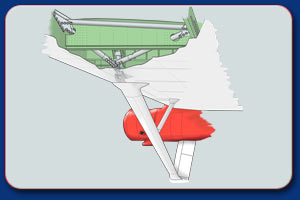 If this was a classic car, a weekend's work would see the problem solved. But it's an aeroplane, so everything has to be documented and approved. You can't just saw bits off until they fit. Our only remaining option was to make new components. But the same documentation and approval requirements get in the way of that solution too. Before we could begin we had to find the original drawings.
If this was a classic car, a weekend's work would see the problem solved. But it's an aeroplane, so everything has to be documented and approved. You can't just saw bits off until they fit. Our only remaining option was to make new components. But the same documentation and approval requirements get in the way of that solution too. Before we could begin we had to find the original drawings.
So another search began, and finally a set of drawings were unearthed in a bundle of specifications belonging to one of the OE suppliers to Scottish Aviation. Then another obstacle rose up. The alloy specified for the braces is no longer manufactured. A modern replacement is many times stronger and more durable, but a material change has to be approved by the Civil Aviation Authority. And that takes time.
But we're on the final lap at last. We've no doubt that the modification will be approved, and the Twin Pin can spread her wings again. But before she can feel the wind under them we'll need to deep strip her Leonides engines - she's been grounded for too long to just fire up and go.
The saga of bringing the world's only flying Twin-Pin back into service is typical of the challenges we face every day. It's relentless, frustrating and frighteningly expensive. But when we see Primrose raise her tail before the wheels have even begun to turn; when we once again watch her performing her physics-defying low speed antics, it'll all be worth it.

